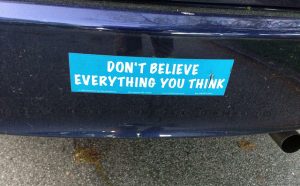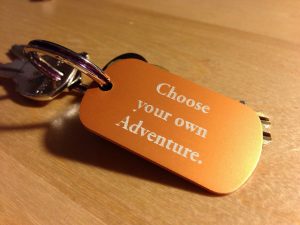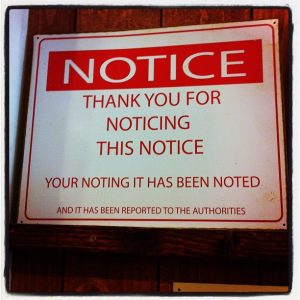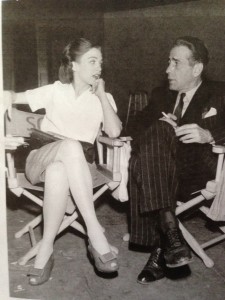Posts by Sarah Callender
This past March, a man climbed an enormous sequoia tree in downtown Seattle. Refusing to come down, he threw branches, pine cones, an apple and other debris onto the police below. He stayed there for more than twenty-four hours, and by the time he descended, he had stripped many branches from the upper half of the tree. The damage to the sequoia was assessed at $7800, not including the cost of the time and resources used by the Seattle Police and Fire Departments.
The next day, I heard someone on the radio refer to this man as “the whackjob in the tree.”
Such casual use of this word, “whackjob,” delivered the one-two punch to my gut and to my heart. As someone with a diagnosis of Bipolar 2 (Bipolar Disorder being the condition formerly known as Manic Depression), I think quite a lot about how the language we use to describe those with a mental health condition allows us to ignore the hurt, marginalization, helplessness and hopelessness felt by those who struggle. Oh, the power of words.
Read MoreA few months back, I woke in the middle of the night with an epiphany: My protagonist is a cartographer! I have always loved staring at maps: imagining the poor dears who live in Boring, OR. The taut-tushed inhabitants of Superior Bottom, WV. The inquisitive folks of Why, AZ.
And I love maps because cartographers are visual storytellers. From a map I can instantly identify the story of, for example, commercial airline hubs around the world, the logistical hurdles of walking from my house to yours, the location of Seattle’s 1,692 coffee shops, the projected trends in glaciers, world religions and peanut allergies.
Below is a story that appears to tell why, based on the number of red counties, Kerry and Edwards should have waved their blue flag long before the first Tuesday in November 2004.
But Mark Newman‘s map below shows each county in a size proportional to its population. From this, we see a different story: the election was far closer than the first map suggests, so close that if Kerry and Edwards had won Ohio, they would have won the White House. Oh, OH10!
In this map there’s no reason for Newman to include mountain ranges or bodies of water, highways or state capitals. That level of detail would only muddy the story of the 2004 election and conceal the map’s true purpose. That said, if a map doesn’t contain enough detail, the user can lose her bearings. Plus a too-empty map tells a boring story. Much like this map of Boring, Oregon.
Read MoreUntil last week, I was reading three books at once, all of which included a whole lot of human suffering.
Book #1: the Bible, specifically the Book of Job, a book that reminds me that at any moment, God could takest everyone and everything away and give me skin ulcers. I wouldn’t be reading it except I’m in a Bible study, and I am a teacher’s pet when it comes to homework.
Human Suffering book#2, Shelter in Place, by Alexander Maksim, is my before-bed book, meaning I read it for roughly four minutes before my body does that herky-jerky thing that babies do as they fall asleep. This one’s about murder and justice, domestic abuse and mental illness. Yippee.
My third book, Hanya Yanagihara’s A Little Life, I experienced via Audible, listening while the puppy and I were out on walks, or as he likes to call them, Las Persecuciónes de la Ardilla. Squirrel Hunts. A Little Life is the most painful, most deep dive into the most darkened lives of human beings I have ever read. It was traumatic. And I loved it.
With A Little Life completed, I went in search of a lighthearted Audible book and came across Steve Martin’s memoir, Born Standing Up, narrated by Martin himself. Yes, I thought, the perfect voice to hear whilst out on squirrel persecutions.
What I got from Martin was a beautiful story of passion, perseverance and the desire for precision in his work. His commitment to his arts, along with his success in comedy, acting and writing, reminded me of what we need to survive and grow as fiction writers.
First, You Never Arrive
Martin explains:
There was a belief that one night on The Tonight Show made you a star. But here are the facts. The first time you do the show, nothing. The second time you do the show, nothing. The sixth time you do the show, someone might come up to you and say, ‘Hi, I think I met you at Harry’s Christmas party.’ The tenth time you do the show, you could conceivably be remembered as being seen somewhere on television. The twelfth time you do the show, you might hear, ‘Oh, I know you. You’re that guy.’
In other words, it can take forever to break in. In other, other words, no one thing guarantees an artist a lifetime of financial success and renown, much less a quick trajectory to fame and riches.
Read MoreThere is no excerpt because this is a protected post.
Read MoreAfter the recent death of Gene Wilder, I heard several moving tributes and interviews from the early 2000s. But it was Wilder’s words about his childhood that struck me: after his mother had a heart attack, the heart specialist took eight-year-old Wilder gently by the arm and said, “Don’t ever get angry with your mother. Because you might kill her. Try to make her laugh.”
I imagine Wilder held tight to these words, this myth: If I don’t get angry with my mother, if I can make my mother laugh, then I’ll still have a mother.
I also imagine this myth propelled the young Wilder on a quest to use his wise and gentle humor to get others to laugh, to keep people well, to keep people alive. How fortunate that so many of us have been the beneficiary of Wilder’s humor and dramatic talent. But believing that the expression of a particular emotion could kill one’s mother? What a burden for a child to bear! At what point did Wilder realize the doctor’s words were hyperbole? What impact did this realization have on Wilder? Was he grateful for the doctor’s words that set him on a particular trajectory, or did he chafe at the doctor’s well-intentioned manipulation?
Read MoreThis past June, I got a tattoo: three ginkgo leaves that span nearly the length of my inner forearm. The leaves dance in an invisible breeze, and I love it. My mother-in-law believes it’s a temporary tattoo, one that will rub off with summer swims in Seattle-area waters of body—lakes, canals, chlorinated pools, Puget Sound. But no, it’s not going anywhere.
One of my dear friends and writing partners told me, “You know what I love most about your tattoo?” Without waiting for me to answer, she waved her hands in circles, palms open toward me, indicating my whole exterior: my Capri pants and gingham-checked blouse, probably my cross necklace too. “This,” she said. “This outfit and you and a tattoo. It doesn’t make sense in all the right ways.”
Getting a tattoo, however, was not about getting a tattoo. It was all about the ginkgo leaves.
Read MoreWhen we last left our heroes (i.e. all of you at WU) we were discussing writer’s block, whether it is real, whether it’s just an excuse, whether it’s caused by fear or sloth or perhaps an ill-crafted story.
Today, fearless ones, we are going to explore the two roads we might take when writer’s block descends like the Joker over the Gotham of our stories. Consider this post a bit of a Choose Your Own Adventure.
Choice One: In spite of that terrible feeling of blockage, you keep writing. Keep your tush in your chair. Keep your hands on the keyboard. Keep at it. Keep calm. Keep tinkering. Keep your eye on the goal. Keep up with the Kardashians (no, don’t do that).
Choice Two: When writer’s block attacks your psyche, you can take a break. Take a walk. Take out a book of poetry and read it aloud. Take a bath or a breath or a vacation, even if that vacation is a trip to the grocery store with your elderly neighbor who can no longer drive to get groceries.
Which adventure–keep going or take a break–do you choose? I don’t know, and I don’t know because there is no single right path. That said, in order to make a smart and thoughtful choice, it’s important to consider not Which path do I choose? but What got me stuck in the first place? The answer to this question will help you choose wisely.
Read MorePhoto compliments of Flickr’s Mickey Aldridge
Every Friday I and a few others meet with our pastor to help him brainstorm ideas and applications for his Sunday sermons. He shares the verses that will anchor the sermon; we offer ideas about our interpretation of the passage and brainstorm ways he might make these verses relevant to congregants.
This pastor is so smart and funny, so humble and funny. And funny! Plus he was an English major. I have a wee pastor crush. But each week he feels blocked and stuck and ill-equipped to put so many ideas into a twenty-four-minute sermon. He asked me a few months back about writer’s block.
“Yeah,” I said. “I don’t believe in it. I think it’s just an excuse people use when writing gets hard.”
Later, thinking about my quick dismissal, I realized I was full of hooey. Writer’s block terrifies me, and I don’t want to admit that I have experienced it. But because scary things often lose their power when we discuss and deconstruct them, I’d like to chat about what writer’s block is and from whence it often comes.
Psychologists use the term “fixation” to describe what happens during writer’s block. Essentially we become stuck in a development phase. We cycle, and we cannot break free from the mindset or thought pattern. That sounds about right. When I am blocked, I feel dull and unfunny. I cannot unstick myself. I cannot create. Unfortunately, the ability to create might be the most fundamental element of writing fiction.
So let’s talk about what happens in the creative process. In the 1950s, creativity researcher J.P. Guilford coined the terms “divergent thinking” and “convergent thinking” as the two main elements in the creative process. First there’s the brainstorming (the divergent thinking phase) where the “there are no bad ideas” ideas are dumped onto the playing field. Next comes the convergent thinking phase during which we consider all the brainstormed ideas, gather ideas that feel sticky and meaty, and see how we might arrange and organize those best ideas into something that can build a story.
Read MoreOver spring break, we cashed in my husband’s frequent flier miles and Marriott points and took the kids to Washington D.C. where museums are free and drivers honk their horns 100% more often than Seattleites do. I don’t think car manufacturers even install horns in the cars of Seattle drivers.
A highlight of D.C. was a dip into the Renwick Museum, a gem that stands proud and plucky in the shadow of the big-shot museums. Its current exhibit included sculptures and 3-D art, structures built from thread and twisted branches, glass stones and old growth cedar, tire rubber and thousands of dead insects. The exhibit is called Wonder. It’s wonderful.
In the gift shop, while my daughter ran her hand over a $500 rainbow scarf and looked at me with pleading eyes, I ignored her ridiculousness and picked up a book by Keri Smith titled How to be an Explorer of the World: Portable Art Life Museum.
My daughter kept petting the scarf.
“No one needs a $500 scarf.” I held up the book. “But everyone needs this. And it’s $14.95.”
The format and visuals of the book appealed to me instantly; the text appears handwritten, complete with crossed-out words, underlines, playful lists, simple line sketches and quotes from smart artists. And the message? Pay attention to the world. Notice stuff. Pick up weird things you find when you’re out and about and study them. Observe patterns in both nature and urban areas.
We writers are explorers of the world—the real world and our fictional worlds. We are eavesdroppers and question-askers. We are curious, and we spot connections, themes and symbolism in our culture, jobs, neighborhoods and homes. We have the privilege of experiencing deep purple emotions, jagged edges and glass smooth surfaces, upside-down Technicolor in 3-D. Not-writers aren’t so lucky (she said in a whisper so the not-writers wouldn’t feel too bad about themselves).
Yet we juggle fiction writing, day jobs, caring for children and/or aging parents, mental and physical health. In other words, sometimes we forget to pay attention to the world.
Thank goodness, then, for How to be an Explorer of the World, in which Smith offers fifty-nine Explorations to develop our exploring, noticing, watching muscles, the very fibers we use in our fiction writing.
Read MorePhoto compliments of Flickr’s John Bell.
Today, friends, without charging you a co-pay or forcing you to read your HIPA rights, I am going to share with you the single most important words my mechanic (AKA my therapist) ever said to me.
First though, some context. Around the time of this pivotal tune-up session (circa 2008), I had two tiny children, a mental illness, and a husband who was travelling for work, often to Tel Aviv and Mexico City, Rome and Detroit. During that particular tune-up session, he was in Bangkok, probably at a spy convention or Navy SEAL training. No one believes he’s actually in software sales.
With the time change between Seattle and Bangkok, exorbitant international phone charges, and I assume much tuk-tuk riding on his part, we weren’t able to speak to each other on the phone. It was odd, having no way to reach him, something I had not experienced for as long as we had known each other. I didn’t like it, not one bit. But I realized something surprising while he was away, and sitting on my mechanic’s couch that afternoon, I shared my news.
“You know what?” I said, “I’ve always been so terrified about what I would do if something happened to my husband. But for some reason, this trip made me realize if something did happen to him, it would be awful, terrible, horrible. I mean, it would be devastating.” I took a breath. “But I would survive.”
My mechanic, a Christian-cum-Buddhist-priest, smiled in that peaceful way and nodded his shaved head. “No . . . it would be awful, terrible, horrible. And you would survive.”
I thought about that for a moment, most likely eyeing him as I always eye wise, bald Christian-cum-Buddhists. Of course he was right. I would be devastated and I would survive. Both sides of that sentence could be simultaneously true.
Read MoreFrom left to right: Porter A, Therese W, Kathleen B, Vaughn R, Keith C and Donald M, preparing to submit their work to publishers.
In the late 1990s, I wrote a short story—my first ever—and submitted it to The New Yorker. It was a really amazing piece of fiction, one that reflected dozens of minutes of toil and revision. I do not remember the plot (which suggests there was none) except for one detail: the female character sits on a therapist’s couch, and, wrapped in a blanket like a burrito, floats into the air and–poof!–vanishes.
I am certain this 7,000-word work of art was roughly 7,000 words too long.
More than fifteen years later, I see how many things were wrong with that experience. First, the piece was a piece of garbage. I did not know how to write a story, and I had no one guiding me through the process. I should have sought advice from someone, if not another writer, than at least a friendly barista or the wine guy with the radio voice at the Safeway where I buy cheap Riesling.
Wrong thing #2: I had the gall to submit to The New Yorker. Sure, I had read The New Yorker, usually while waiting for my dental appointments, usually looking at the pretty cover or the cartoons because the stories were, well, a little uppity in my opinion. Perhaps I thought that the inclusion of my story would endear me to the other works of fiction. But certainly, even if my story had been an actual work of art, I was not familiar enough with the publication to know whether it would be a good fit.
These days I am a better writer with a better understanding of story structure, and yes, I carry around suitcases of humility. I have given up trying to like The New Yorker’s fiction and instead peruse People while waiting for my dental checkups. And when I submit an essay or a story, a grant proposal or retreat application, I do so in a much smarter way.
In 2015, I (someone who lives with bipolar disorder 2) got involved in an organization with this goal: reduce the stigma of mental illness by sharing our stories and serving as a resource to others with mental health conditions. With this in mind, I wrote an essay about mental illness in a marriage. Once again I aimed high, and after much revision based on my critique partners’ feedback, I sent the essay to The New York Times. Seven weeks later I received a form letter rejection from the editor: Dear Sarah Callender . . .
A form letter rejection feels crummy. And submitting smartly doesn’t eliminate the possibility of rejection.
After receiving the form letter rejection, I threw a fifteen-minute pity party, then told my puppy I loved him about fifty times. He wagged and replied fifty-one times that he loved me back, and I started researching other places where I could send the piece. After all, it’s the first rejection that’s the hardest. And the second and the third and the fiftieth, and honestly if one more well-intentioned, kindhearted person tells me how many rejections Rowling had before Harry Potter was acquired, I might shriek. She had her manuscript rejected twelve times. Twelve. Big whoop.
But rejection forces me to consider and reconsider just how badly I want to be an author. It tests my […]
Read MoreMy grandmother was born on an east Texas watermelon farm in 1922. At age 17, after she graduated from Beaumont High School, she left for Hollywood and danced in films alongside Mickey Rooney and Judy Garland, hobnobbed with Humphrey Bogart. After she met my grandfather, she left Hollywood and gave birth to four beautiful children, the oldest of whom is my mother. I am the oldest of nine grandchildren. I wish I had inherited her legs.
This past December, she died after a fifteen-year journey with Alzheimer’s, and throughout her decline, she was as light-filled and beautiful as Alzheimer’s is bleak and ugly. I remember, in the earlier stages of the disease, how she would bend down to study a flower with awe and wonder, or stop walking and raise her face to the sky to watch a bird soaring overhead. With childlike wonder, she noticed what we adults consider mundane.
My mother, so involved and committed to my grandmother’s comfort and well-being, intimately cared for my grandmother as the disease rendered her wholly dependent and vulnerable. There was such rawness in my grandmother’s vulnerability; sometimes witnessing the progression of the disease sucked the air from my lungs.
I think about vulnerability quite a lot in both my human life and my writer life. When we bare ourselves, we can feel very chilly. Vulnerability can be painful too: rug burns and splinters may occur with so much bareness. Have you ever poked a snail’s antennae-eyeball and watched it retract? Vulnerability can feel like we are the snails and some human schmo has bent down to intentionally poke our eyeball.
When we are vulnerable, we give someone else a piece of our self, not knowing how it will be received or whether there will be reciprocity. We simply open up our chests to another, hoping that person will appreciate or empathize with our desire to reveal the beauty of a beating heart, praying he will not run screaming.
CAUTION! SOME PEOPLE WILL RUN SCREAMING! That person over there, that sealed-tight, glass-skinned lady with the pretend smile? She likes Valentiney, heart-shaped things, but doesn’t like actual hearts, especially when they aren’t covered up with lots of layers of stuff.
And over there . . . that fellow in the brick box he has built for himself, with just a few gaps for air holes and sunlight, he’s terrified of all organs, especially warm, bare skin, our body’s largest organ of all. He stays in the brick box where it’s safe, where there’s no need to see others’ vulnerability, where there’s no reason to be vulnerable himself.
The decision to live with vulnerability allows others to poke us in sensitive places, but vulnerability can also leave us feeling wholly alive, invigorated and truthful. Vulnerability also connects us more intimately to others. If you’ve tried out vulnerability, you know I’m telling the truth.
Vulnerability: Good for Humans
In his picture-book-for-adults, V is for Vulnerable, Seth Godin, explains, when we are willing to be vulnerable with someone else, we create “imbalance” in the relationship . . . we are admitting that we struggle in some way, knowing full well that the other person might laugh at us, fear us, dislike us. But it’s that imbalance, Godin says, that leads to connection. Yes!
Read MoreThis post-song goes out to you beautiful writers who dream of going pro someday, selling your books for actual money . . . a-one, and a-two, and a-one-two-three-four!
Springtime 2000. I am in my seventh year as a high school English teacher, and I realize I am doing all of the creative writing assignments I give my students, not because I’m a good role model, but because an itchy seed of something is growing in me, and writing is my Calamine-soaked backscratcher.
“I don’t get it,” I tell my friend, Paul. “Suddenly, I need to write. Need to.”
I can hear the shrug in his voice. “So write,” Paul says. “No one’s stopping you.”
The need doesn’t go away, and the constant essay grading and lesson planning doesn’t afford me time to write. After much deliberation, I leave teaching and launch myself into what I call my Silly Job. It is deliciously silly. Boring too. But I work only from 7:30-4:30, earn the same salary I did as a teacher, and have afternoons, evenings and weekends to write.
December 2015. At a New Year’s Eve soiree, when other party-goers ask what I do for work, I say, without even a bit of clumsy bashfulness or self-deprecation, “I write fiction. I’m also an editor and tutor, but that’s just for money. My real gig is writing.” On the way home it hits me: After fifteen years, I am finally comfortable with the sentence, “I write fiction.”
Yikes o’frighty! What took me so long? We are artists, yes; aren’t we also entrepreneurs? Is it possible for us to assume the posture of a professional even before we earn a dime? Yes. It is possible.
Professionals Set Expectations and Boundaries
As a fiction writer, I have no boss or salary or bonus goals. I can write in my pajamas. I can take the afternoon off. I can take every afternoon off. What freedom!
But no one’s going to write my book for me. I need to take advantage of my time to write, and I need to protect it. If I use my lunch hour to write, I should let my colleagues know I’m not interruptable. It’s my writing time, I might say. I’ll talk to you in an hour. I may have to tell my teenager, I have a big project at the office, but I still need to hit my daily word count for my book. I’ll need your help with some housework over the next few months. Or I may have to tell a friend, I’d love to have coffee, but I work from home, and I need to work while my kids are at school.
Our colleagues, teenagers or friends might roll their eyes or have hurt feelings, but that kind of discipline writes novels.
Read More




















